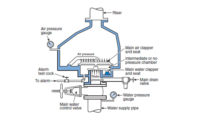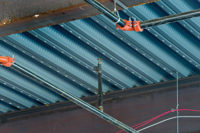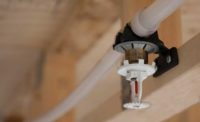There are several different types of inspections that can occur for automatic-sprinkler systems. Some inspections are conducted by the insurance industry to make sure they understand the risks present in a given building and that the systems installed are designed to mitigate those risks.
Another type of system inspection is by the local fire service. These inspections may be infrequent and unscheduled, however their purpose is to make sure the systems are in proper working order and that all applicable laws and safety standards have been met. A final type of system inspection is the NFPA 25 “wear and tear” inspection. This inspection is typically carried out by an ITM service provider hired by the property owner for the facility manager.
No matter which inspection is being conducted, it is critical for all parties to understand the purpose of the specific inspection and the roles and responsibilities of the various stakeholders involved. Of the three inspections noted above, the most frequently conducted, but also most frequently misunderstood, is the visual inspection required by NFPA 25.
NFPA 25 is an internationally recognized inspection, testing and maintenance standard for water-based systems. In the U.S., it is adopted in the majority of states through either the fire code or the building code. Unlike insurance inspections and fire-service inspections, NFPA 25 inspections are required by law to be conducted on a periodic basis, irrespective of the use, occupancy or hazards of the building.
While these water-based systems are required to be inspected (typically on an annual basis), the purpose and methodology for conducting the inspection is not always well understood. The following topics represent some of the most misunderstood concepts when carrying out NFPA 25 inspections.
Scope of inspection
Probably the biggest misconception with NFPA 25 is the individual conducting the inspection is essentially recommissioning the sprinkler system. While this might be the case in a perfect world, this level of inspection far exceeds the expectations of the standard. It is not the function of the annual system inspector to confirm that all systems and system components comply with the design standards such as NFPA 13 or NFPA 24 every time they walk into the building.
NFPA 25 assumes the fire protection systems installed in a given building complied at the time of construction or last modification, therefore the NFPA 25 ITM service provider is not looking to validate the design, but rather to confirm the systems and system components that are in place are still in good working order. Therefore the appropriate questions for the ITM service provider to ask themselves are not “Are those sprinklers spaced correctly?” or “Does that exit sign create an obstruction per NFPA 13?” but rather “Is there paint on the bulb of that sprinkler?” or “Is that coupling leaking?”
The inspector should not be concerned whether the correct component has been installed. But, assuming that it is the correct component, does it look as if it is in proper working order? Therefore, the inspections per NFPA 25 will focus more on wear and tear or mechanical damage present on the systems.
Inspection from floor level
Another misconception with NFPA 25 is the depths to which the ITM service provider must go in conducting the inspection. As noted above, the inspector is looking for wear and tear on sprinkler system components, therefore it would be logical to assume that they would need to see each device up close. NFPA 25 is very clear, however, that the sprinkler system inspection required by Chapter 5 should be conducted from floor level without the need for a mechanical lift or other devices to help get a closer look at sprinklers. While bringing in a scissor lift to see every sprinkler at the ceiling in a 45 ft. warehouse would be ideal, this would increase the cost of conducting the inspection to the point where many owners would simply not have the inspection conducted.
Therefore, when a sprinkler system inspection is performed for a building with a higher ceiling, the inspector should note what they were able to see and what was out of their range. Some inspectors will bring binoculars or cameras that will allow them to get a closer look at each sprinkler. While this is certainly permitted, NFPA 25 does not require the service provider to go to this length to conduct the inspection.
The standard also excuses the service provider from inspecting above suspended ceilings and solid gypsum ceilings. The logic for omitting these areas from the inspections is once again a cost-related one.
Identifying unprotected areas
There is a common misconception the ITM service provider is required to identify all areas of the building that are not protected by sprinklers. The idea of calling out unprotected areas fits more closely with the description of a system design evaluation as opposed to a wear-and-tear inspection, and is therefore outside of the scope of the NFPA annual inspection.
That’s not to say service providers shouldn’t inform building owners that there may be unsprinklered areas, only that doing so is outside the expected scope of the inspection. The problem with providing a client with more information than required is it can expose the inspector to liability.
If an inspector is identifying some unsprinklered areas on his or her NFPA 25 inspection report, but not all of them, the line can become blurred as to what service is actually being provided. Many owners believe NFPA 25 requires the inspector to conduct a design evaluation, so when an inspector provides a few design issues mixed in with proper NFPA 25 deficiencies, it can further muddy the waters.
Inspection documentation
In its early days, NFPA 25 used to contain a series of forms that could be used by the ITM service provider to document their findings. These forms were never mandated as the only method of documentation for an inspection. However, they quickly became adopted by many jurisdictions as their preferred method for documenting activities.
The technical committee that develops NFPA 25 took the forms out of the standard more than a decade ago since they were not being used properly and were causing more harm than good when it came to the enforcement of the standard. In its present form, the standard does not require a specific form to be filled out.
The means of documenting deficiencies noted to the owner is at the discretion of the service provider. It is helpful if the property owner (or its representative) communicates to its service provider what expectations it have for documentation of the inspection in the contract. Many owners expect to get forms and checklists with photographs of deficiencies when an inspection is conducted, however these items are not called out by NFPA 25. Where specific forms of documentation are desired, it should be addressed in writing before the inspection takes place.
Breaking down the who, when and why of the inspection can make things easier to understand and help to assure inspections are being carried out as intended.



